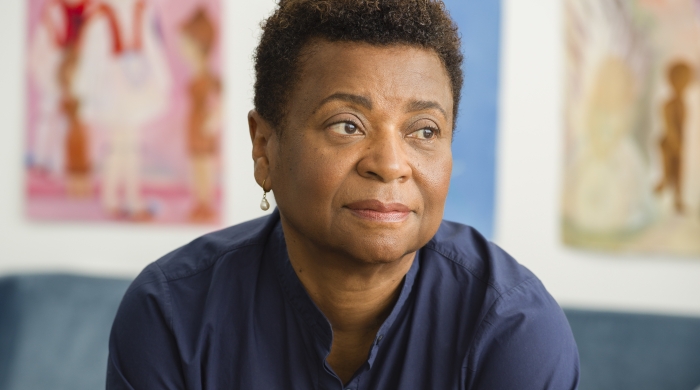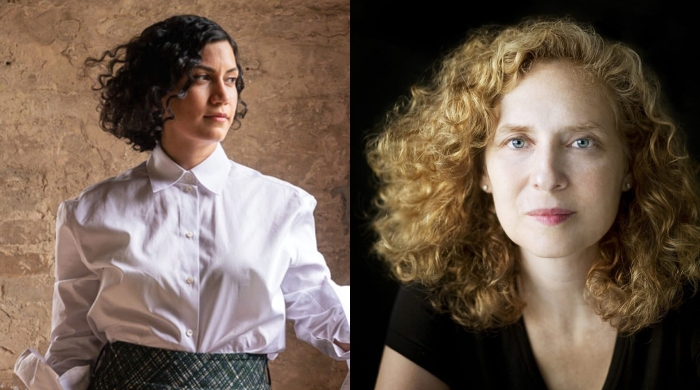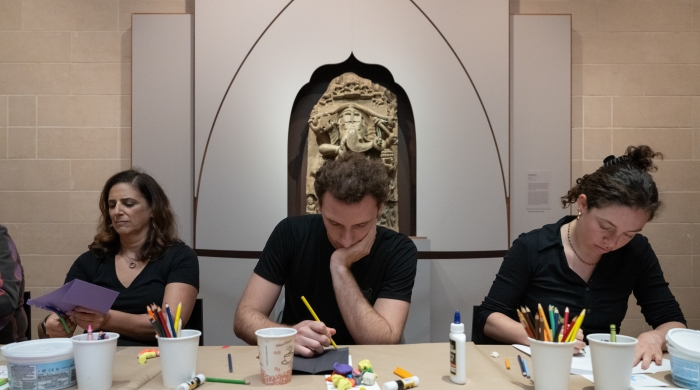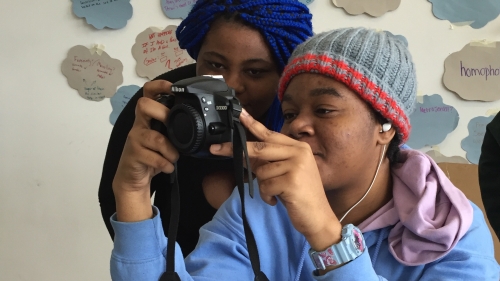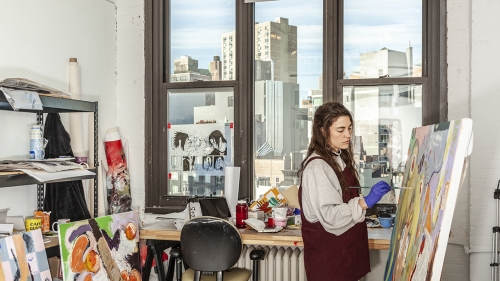Lyle Ashton Harris, NYU Steinhardt professor of art and art education, is the subject of a solo exhibition, Our first and last love, on view through September 22 at the Queens Museum.
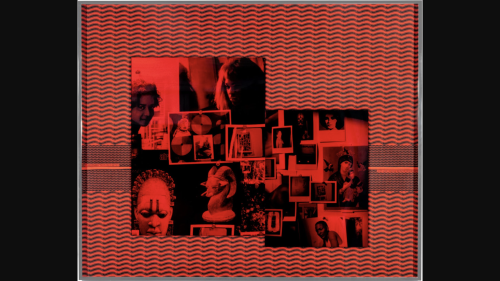
"Queen Mother," one of the Shadow Works series from Lyle Ashton Harris. Courtesy of Lyle Ashton Harris.
Minutes after entering his Chelsea studio, Lyle Ashton Harris sat at a light table, eyeing a strip of negatives through a photographer's loupe. Working with assistant (and recent NYU Gallatin graduate) Benji Hsu and intern and rising senior at Gallatin Melia Chendo, Harris explained his process in rapid fire bursts as he located the images.
“These are from the Constructs series, from 1989. They were seminal works in the Whitney show ‘Black Male,’ curated by Thelma Golden,” he tells a reporter, referring to the landmark 1994 exhibition Black Male: Representations of Masculinity in Contemporary American Art at the Whitney Museum of American Art.
Harris was pulling negatives – from Constructs and an earlier series, Americas – for curators in London, where the photographs will be included in The 80s: Photographing Britain, a group show that will be on view at the Tate Britain from November 21 – May 5, 2025. Harris will be the only non-British artist in the exhibition.
Currently, Harris’s work is showcased in Our first and last love, a solo exhibition at the Queens Museum through September 22. Co-curated by Caitlin Julia Rubin and Lauren Haynes, it features more than 40 works spanning 35 years. It opened at the Rose Art Museum at Brandeis University in February of 2023 before moving to the Nasher Museum at Duke University last August. The Queens Museum version includes works dating to the late 1980s, when Harris was still in college, through his most recent series, Shadow Works.
Hailed by The New York Times as a “groundbreaking Black portrait artist,” Harris is celebrated for self-portraits, photography, and assemblages that employ nudity, guns, masks, photographs, and ephemera to examine his own identity as a queer Black man and the social constructs of race and gender.
His work has been exhibited at the Whitney, the Guggenheim Museum, the Studio Museum of Harlem, and the Tate museum, among many others. His portrait of Golden recently accompanied a New Yorker profile of the renowned art leader.
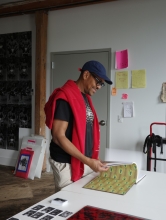
Photo by Ryan Rusiecki.
Born in the Bronx in 1965, Harris grew up in Dar es Salaam, Tanzania, and in New York before he enrolled in Wesleyan University with the idea of studying economics. But a summer trip to Amsterdam to visit his older brother, filmmaker Thomas Allen Harris, set him on a different course.
He graduated Wesleyan with an art degree, then went to the California Institute for the Arts (CalArts) for an MFA. His mother was a chemistry professor, so it’s not surprising that he began teaching in 2005.
“I was invited to help jumpstart the NYU Accra program in Ghana,” he says. “It was a one-semester appointment and I fell in love with the people and the culture, and it somehow became a three-year appointment.” He has been on the faculty of NYU Steinhardt School of Culture, Education, and Human Development since 2005, and currently works as a professor of art and art education in the Department of Art and Art Professions.
During a whirlwind week in which he was honored at the Queens Museum’s annual gala, Harris spoke with NYU News about the exhibition and his approach to art and teaching.
Our first and last love showcases 35 years of your work. How did you decide what to include, and why did you decide to display the pieces thematically rather than chronologically?
We decided to do a thematic show and use the Shadow Works series as the anchor. It is structured around certain themes and clusters, for example, family, desire, intimacy. There are certain tropes that have persisted over the years. It is interesting to see, from a viewer’s standpoint, how these ideas were present early in the work and have persisted over three decades.
One review of the exhibition suggested that you are comfortable with complications. What do you think of this description?
I think we all live complicated lives in complicated worlds. My work has been a wonderful opportunity to mine some of those ideas, to use the process of art to explore and to lay bare what is present in all of our lives.
It’s not that I’m wrestling with these questions. Society is wrestling with them. I am one of several artists who are engaged with these issues. What’s interesting is that the early work is prescient in terms of its exploration of these issues, issues that now have become part of the academy. I studied with [writer and theorist] bell hooks as a first-year graduate student. There was something about those works that resonated because they explored in a complicated way issues of identity and sexuality and race within one frame, as opposed to being bifurcated.
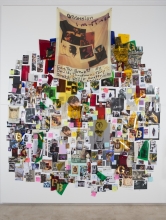
Lyle Ashton Harris's “Obsessão II,” a mixed media collage from 2017. Courtesy of Lyle Ashton Harris.
That is really tangible in the exhibition, the long arc of your investigation into the intersections of race, sexuality, and gender – and your place in the Black arts movement.
It’s not Black culture, it’s any culture. Certain things get told and certain things get left to the side. But this stuff has a way of finding its proper place in history.
How does your experience as a student, both undergraduate and graduate, influence your teaching?
I would say that I’m deeply committed to nontraditional teaching. I focus on the experience. I see it as a laboratory, and the students understand that this is going to be a situation where they are actively engaged, that they are going to take part in it – and if they are not part of it, that will be to their detriment. That’s less a threat than an invitation. It’s a journey that we are going to share together.
Does teaching, and being around students, influence your art?
Without question. This is the way I work and it’s not just teaching in a class, per se. It is not uncommon for me to have deep friendships and connections with former students, to develop close friendships and academic allegiances and to continue to support each other. It keeps me young.
I think it helps that they can see I'm very much involved in my practice and what it means to be an artist. I bring those experiences into the classroom. I encourage them to see exhibitions, to be actively engaged in the art world. And at the same time, I have to show up and engage with them, particularly like the semester that’s just over, in terms of the complexity that we’re living in. It is something that is mutually engaging.
Press Contact
(212) 998-6829
Related Articles
2024 Dorothy Height Distinguished Alumni Award Honoree: Philemona Williamson (MA ’79)
Get to know the narrative painter, educator, and Dorothy Height Distinguished Alumni Award winner.
Two Steinhardt Faculty Awarded 2024 Guggenheim Fellowships
A composer and a visual artist are among the 188 individuals from 84 academic institutions who have been awarded the prestigious fellowships.
Art Therapy Program Brings Creative Self-Discovery to the Rubin Museum
This fall, Steinhardt’s graduate Art Therapy program offered a free weekly program, Healing Through Art, to visitors at the Rubin Museum.
Related Programs
Related Department
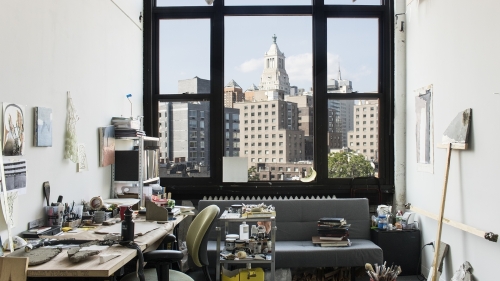
Art and Art Professions
Barney Building
34 Stuyvesant Street, New York, NY 10003
212-998-5700
nyuart@nyu.edu

